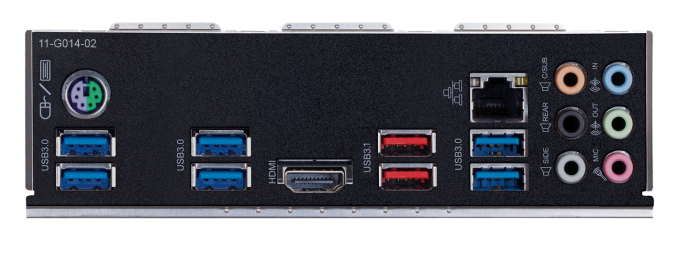Intel Z390 Motherboard Overview: 50+ Motherboards Analyzed
by Ian Cutress & Gavin Bonshor on October 8, 2018 10:53 AM EST- Posted in
- Motherboards
- Intel
- MSI
- Gigabyte
- ASRock
- EVGA
- Asus
- NZXT
- Supermicro
- Z390
GIGABYTE Z390 Gaming SLI
Not all of GIGABYTE's gaming range is underneath the Aorus banner and the primary example on the Z390 chipset is the Z390 Gaming SLI. In regards to the design, the board has a black color scheme throughout with slim red accents on both the power delivery and chipset heatsinks. The board makes use of three full-length PCIe 3.0 slots with the top slot operating at x16, the middle slot at x8 and the bottom at x4. The top and middle slot have a coating of metallic slot protection and due to the middle slot operating at x8 and as the name suggests, this model does support two-way SLI graphics configurations. The onboard Realtek ALC1220-VB codec has EMI shielding and the power delivery looks to be running in an 8+4 or 10+2 configuration; this is supplemented by a pair of 12 V ATX CPU power inputs which consists of an 8-pin and a 4-pin.
Memory support on the Z390 Gaming SLI consists of four RAM slots with a maximum capacity of up to 64 GB; the maximum rated XMP profile is currently unknown as of yet. The onboard audio is provided by a Realtek ALC1220-VB audio codec which offers six 3.5 mm audio jacks on the rear panel; the single LAN port is controlled by an Intel I219V Gigabit networking chip. A total of eight USB Type-A ports are present which are split into two USB 3.1 Gen2 and six USB 3.0, with a combo PS/2 port and a single HDMI video output also present.
While this board is similar in spec to the Z390 Aorus Elite, it currently costs just $160 and represents one of GIGABYTEs cheapest Z390 models at launch. Based on this the targetted segment is likely to be budget gaming with certain cost-cutting measures in place such as rear panel connections, but without sacrificing on support and componentry such as power delivery needed to run Intel's top 9th generation processor the Core i9-9900K.












79 Comments
View All Comments
Smell This - Tuesday, October 9, 2018 - link
Much.Of.
The.
Same.
2 HSIO lanes per Gen 2 port and WiFi. Wow (rolling I-eyeballs) ...
MadAd - Tuesday, October 9, 2018 - link
58 motherboards, only 13 of which are smaller than ATX. When on earth are we going to move off this outdated oversized format? Its just more of the same every time, so depressing.gavbon - Wednesday, October 10, 2018 - link
13 is better than 0, or 12 :DMadAd - Wednesday, October 10, 2018 - link
Considering very small form formats (ITX) are harder to build for and only 7 are uATX, a size which is the most useful to transition away from ATX then no, it feels like an afterthought from a lazy industry. I mean who uses more than 1 main video card and 2-4 sticks of ram in a gaming PC these days? Even water builds into uATX isnt that hard to accomplish.After literally decades ATX should be a choice for edge cases not a mainstream build.
shaolin95 - Monday, October 22, 2018 - link
who cares about midge boards!Edkiefer - Wednesday, October 10, 2018 - link
All these MB with 2x 8 pin power inputs, is both mandatory and if so I guess new PSU will need 2x 8pin now.entity279 - Wednesday, October 10, 2018 - link
so it's ok to just buy SM motherboards now with them being involved in a security scandal?gavbon - Thursday, October 11, 2018 - link
I currently have the Supermicro C9Z390-PGW awaiting to go on the test bench next week, so from a consumers standpoint, I could potentially shed light on that board. As far as the Chinese/Supermicro/Spy scandal goes, I don't want to speculate without the finer details.eastcoast_pete - Wednesday, October 10, 2018 - link
Ian & Gavin, thanks for the overview.@ both - Question: I've read that Intel, to deal with its bad planning/capacity problems on 14 nm, has contracted the fabbing of some of its chipsets out to TSMC, specifically in TSMC's 22 nm tech. Is that correct, and did you have a chance to confirm that the new 390s used by these boards are indeed made by Intel on their 14 nm FinFET tech, or are they made by a contractor (TSMC)?
DanNeely - Wednesday, October 10, 2018 - link
AFAIK the chipsets being reverted to 22nm are using Intel's 22nm process in old unupgraded fabs. Doing so would be far less work than porting to a process from a different company; the latter would require massive rework to follow a completely different set of design rules.